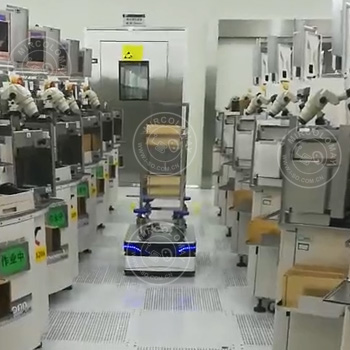
News
The page position: Home > English > News >
Calling and Scheduling of AGV Unmanned Handling System
Release day:2019-04-15
Mircolomay AGV Project Engineer said: Complex AGV system requirements usually require AGV to have remote scheduling capability, to respond to operator or system needs. Such system applications require AGV technology to support AGV remote communication to determine the status, location and commands of AGV unmanned carrier.
The implementation of AGV call system includes the following methods:
 In these cases, an interface can be provided directly between the device controller and the AGV caller, allowing automatic signaling when a load is ready to be picked up. Automatic calls can also be generated with sensors (limit switches, glasses, etc.) installed at the load points of the call station.
In these cases, an interface can be provided directly between the device controller and the AGV caller, allowing automatic signaling when a load is ready to be picked up. Automatic calls can also be generated with sensors (limit switches, glasses, etc.) installed at the load points of the call station.
The first call/scheduling scheme is more common. When the dispatching center receives the call request from the caller, it first confirms the calling site and the type of the called AGV car, and inquires whether there are idle vehicles in the AGV queue. If there are no idle vehicles, the current call will be stored in the call queue according to the first-in-first-out mode. Before dispatching the call, the additional multiple calls from the same site will be ignored. The green light is flashing while the caller is waiting for the dispatch. When an idle AGV car appears, the shortest path between the starting point and the end point is calculated, and the AGV car reaches the destination according to the shortest path. In the process of dispatching, the green indicator of the caller turns on long, until the AGV arrives at the calling station, the indicator lights out.
The implementation of AGV call system includes the following methods:
- Simple calling button---At each AGV call point, provide a button, a rope, or a switch.
- Keyboard terminal---AGV call points are equipped with PC terminals or touch keyboards/displays.
- Automatic calling-- Call stations can be part of an automation process, such as the output of stretch film winders, palletizers or production lines.

The first call/scheduling scheme is more common. When the dispatching center receives the call request from the caller, it first confirms the calling site and the type of the called AGV car, and inquires whether there are idle vehicles in the AGV queue. If there are no idle vehicles, the current call will be stored in the call queue according to the first-in-first-out mode. Before dispatching the call, the additional multiple calls from the same site will be ignored. The green light is flashing while the caller is waiting for the dispatch. When an idle AGV car appears, the shortest path between the starting point and the end point is calculated, and the AGV car reaches the destination according to the shortest path. In the process of dispatching, the green indicator of the caller turns on long, until the AGV arrives at the calling station, the indicator lights out.


